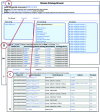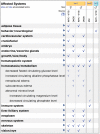Mouse Genome Database (MGD)-2018: knowledgebase for the laboratory mouse
- PMID: 29092072
- PMCID: PMC5753350
- DOI: 10.1093/nar/gkx1006
Mouse Genome Database (MGD)-2018: knowledgebase for the laboratory mouse
Abstract
The Mouse Genome Database (MGD; http://www.informatics.jax.org) is the key community mouse database which supports basic, translational and computational research by providing integrated data on the genetics, genomics, and biology of the laboratory mouse. MGD serves as the source for biological reference data sets related to mouse genes, gene functions, phenotypes and disease models with an increasing emphasis on the association of these data to human biology and disease. We report here on recent enhancements to this resource, including improved access to mouse disease model and human phenotype data and enhanced relationships of mouse models to human disease.
© The Author(s) 2017. Published by Oxford University Press on behalf of Nucleic Acids Research.
Figures



References
-
- Brown F.C., Scott N., Rank G., Collinge J.E., Vadolas J., Vickaryous N., Whitelaw N., Whitelaw E., Kile B.T., Jane S.M. et al. ENU mutagenesis identifies the first mouse mutants reproducing human β-thalassemia at the genomic level. Blood Cells Mol. Dis. 2013; 50:86–92. - PubMed
Publication types
MeSH terms
Grants and funding
LinkOut - more resources
Full Text Sources
Other Literature Sources

